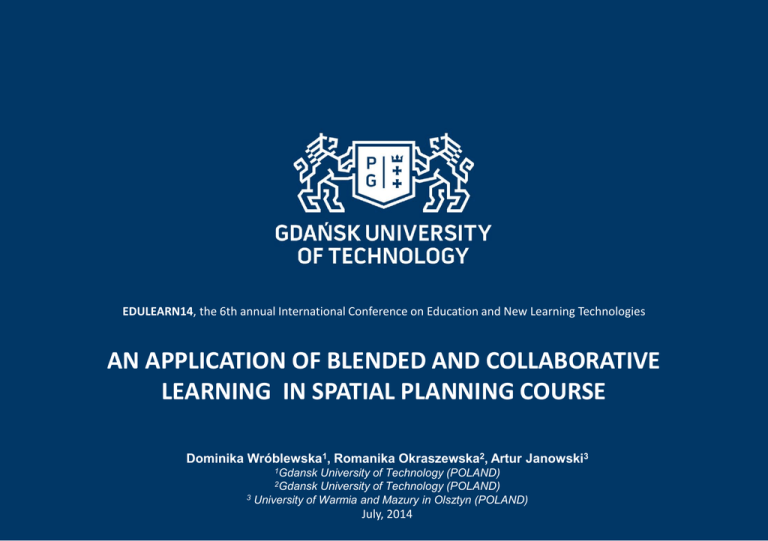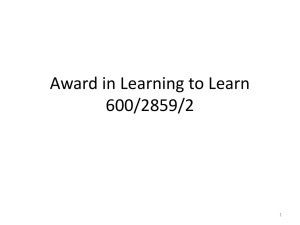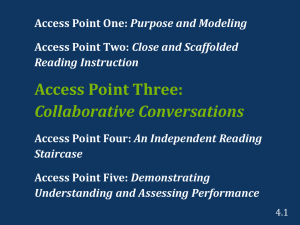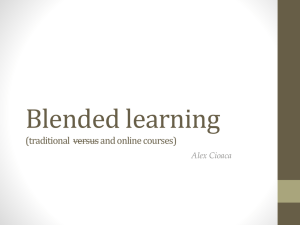Romanika Okraszewska
advertisement

EDULEARN14, the 6th annual International Conference on Education and New Learning Technologies AN APPLICATION OF BLENDED AND COLLABORATIVE LEARNING IN SPATIAL PLANNING COURSE Dominika Wróblewska1, Romanika Okraszewska2, Artur Janowski3 1Gdansk University of Technology (POLAND) University of Technology (POLAND) 3 University of Warmia and Mazury in Olsztyn (POLAND) 2Gdansk July, 2014 Plan of a presentation 1) E-LEARNING. GLOBAL TRENDS AND EXPERIENCES OF GDANSK UNIVERSITY OF TECHNOLOGY 2) CASE STUDY Goals, effects and outputs Course Structure Collaborative work Course evaluation 3) SUMMING UP REFERENCES Wróblewska D., Okraszewska R., Janowski A., AN APPLICATION OF BLENDED AND COLLABORATIVE LEARNING IN SPATIAL PLANNING COURSE E- learning. Global trends and experiences of university. Gdansk University of Technology Gdansk University of Technology: • a modern university, • promotes solutions and strategies that take advantage of technology development, E-learning at the university: • in accordance with the relevant legislation [4],[5] and internal procedures [6]. • based mostly on a blended learning educational model, • provided by Moodle, the university e-learning platform. Wróblewska D., Okraszewska R., Janowski A., AN APPLICATION OF BLENDED AND COLLABORATIVE LEARNING IN SPATIAL PLANNING COURSE E- learning. Global trends and experiences of university. Moodle Platform Access to teaching materials and the following e-components: • text files, • audio, • multimedia presentations, • videos, • mobile applications, • interactive teaching modules, • educational games, • blogs, webcasts, • instant messaging • remote communication (synchronous or asynchronous) between the participants of the learning process. Wróblewska D., Okraszewska R., Janowski A., AN APPLICATION OF BLENDED AND COLLABORATIVE LEARNING IN SPATIAL PLANNING COURSE Case Study Goals, effects The course in Spatial Planning: • run for Master’s students of Environmental Engineering, • worth 3 ECTS credits, • delivered through individual and group project work (groups of 5-6 students), • based on case-based learning, Main learning objectives: • to introduce students the set of spatial planning issues referring to environmental engineering aspects, such as water systems management and others • to develop skills of collaborative planning and decision making. The expected effects: • gaining the knowledge of the spatial planning system and it relations to environmental engineering issues, • understanding urban space complexity, its structure and relation between components taking into consideration spatial order and sustainable design, • data managing by acquiring appropriate data form site visits and virtual trips (Google maps, Street View), form GIS and WMS systems, literature and other documents, their integration, analysis and visualization, • demonstrating the ability to conduct collaborative team project work in a spatial planning process. Wróblewska D., Okraszewska R., Janowski A., AN APPLICATION OF BLENDED AND COLLABORATIVE LEARNING IN SPATIAL PLANNING COURSE Case Study Project, subprojects and outputs Project The Oliva Stream Waterfront in Gdansk (The choice of the water basin was based on the variety and complexity of the urban space along the stream, which runs through the nearby woods, suburbs, district center and ends in the Baltic Sea). The Oliva Stream Waterfront in Gdansk SUBPROJECT BASED ON OUTPUT I - Space inventory identification of space conditions such as: land use, water use, hazards, building function, protected objects and areas etc. a map drawn in Auto Cad and a written report II - SWOT analysis based on inventoried space conditions within subproject I, and final conclusions involved development conditions. a written report III - Waterfront inspiration based on case studies known from the literature, web or individual practice a multimedia presentation presented to the public and discussed IV – The Olive Stream waterfront changes proposal - based on subprojects II and III. a poster, presented to the public and discussed Wróblewska D., Okraszewska R., Janowski A., AN APPLICATION OF BLENDED AND COLLABORATIVE LEARNING IN SPATIAL PLANNING COURSE Fig. 1. Relations between course components. Course structure Components Fig. 1. A blended learning course struture. Relations between course components. Wróblewska D., Okraszewska R., Janowski A., AN APPLICATION OF BLENDED AND COLLABORATIVE LEARNING IN SPATIAL PLANNING COURSE Course structure Components Learning objectives Course elements supporting objectives Gaining the knowledge of the spatial planning system and it relations to environmental engineering issues. Understanding urban space complexity, its structure and relation between components taking into consideration spatial order and sustainable design Data managing by acquiring appropriate data form site visits and virtual trips (Google maps, Street View), form GIS and WMS systems, literature and other documents, their integration, analysis and visualization. Demonstrating the ability to conduct collaborative team project work in a spatial planning process. Traditional approach E-course Lecture Literature Reading Project Presentations Discussion Final written test Lecture Literature Reading Project Presentation Final written test Discussion Project: Site visits Literature Reading Discussion Project Voting Glossary Quiz Project Discussion Others Participation in external activities Consultation Glossary Project Voting Project: Links Database Assessment sheet Glossary Table 1. Relations between course components and learning objectives. Wróblewska D., Okraszewska R., Janowski A., AN APPLICATION OF BLENDED AND COLLABORATIVE LEARNING IN SPATIAL PLANNING COURSE Course structure Components Course components Activity Group Individual Obligatory, assessed Lectures Literature Reading Project Presentation Discussion Final written test Information Table Database Glossary Assessment sheet Quiz Voting Links Consultation External activities x x x x x Non-obligatory, assessed. Students can improve the final grade Non-obligatory, not assessed. Chosen to support students learning process. x x x x x x x x x x x x x x x x x x x x x x x x x x x x x x x Table 2. Course components and their relation to activities Wróblewska D., Okraszewska R., Janowski A., AN APPLICATION OF BLENDED AND COLLABORATIVE LEARNING IN SPATIAL PLANNING COURSE Collaborative work Different approaches Rules: • Groups of five to six people, • Students’ choice with whom they wanted to work, • No leader or project manager, • All subprojects instructions, acces to database avaiable, • No no written support on collaborative working. Different approaches to collaborative work in order to achieve subprojects’ goals For example, subproject II SWOT (elaborated during classroom discussions). . The SWOT analysis consisted of four small analyses: strengths, weaknesses, opportunities and threads. The groups presented three different approaches: • One or two individuals analyzed SWOT and the rest of group members accepted the result without any discussion. • Some students worked separately on the SWOT analysis and on completion they gathered the results to produce the final output. They did it without any negotiations or discussions, assuming that all the results were true and correct. In this case we would rather say it was cooperative than collaborative work. • Some students collaboratively discussed each single analysis and wrote final conclusions. These groups found more effective solutions as they generated a greater number of ideas. Wróblewska D., Okraszewska R., Janowski A., AN APPLICATION OF BLENDED AND COLLABORATIVE LEARNING IN SPATIAL PLANNING COURSE Course evaluation Base Course evaluation was based on: • Evaluation students feedback at the end of the course, • Submissions terms of the subprojects, • Final marks, • Teachers’ observations during face-to-face project meetings, lectures and consultation hours. • Delivery strategies assessment on the basis of the amount of students using them, • The final output, the content, information provided for the learners. Wróblewska D., Okraszewska R., Janowski A., AN APPLICATION OF BLENDED AND COLLABORATIVE LEARNING IN SPATIAL PLANNING COURSE Course evaluation Details • Assessment sheets – they were presented to the students so that they could get familiar with them before submitting the final output. It occurred that in most cases the sheets required small modifications as the activities, approaches, ideas or solutions were quite innovative, which was not taken into account. Thus, in the future, all assessment sheets will be enriched by the possibility of assessing the students’ approach, and they will give teachers the chance to evaluate the group approach to problem solving. This can result in hybrid assessment linking computer and teacher evaluation. The assessment sheets also indicated that some of the subproject components were extremely difficult to the students. That is why, the issues of space composition will be excluded from the sheet and not assessed any more. • Quiz - the main problem was no access to a computer laboratory. The students were to undertake this activity at home at suitable time within three days. It was difficult to assess if the Quiz was done by each student on their own or not. In the future the quiz questions database will be rebuilt and enriched to include a wide range of questions. • Voting – this activity’s aim was to make the students familiar with as many presentations as possible so that they could gain inspiration and knowledge for their future work. It occurred that the students looked through the presentations, but did not vote on them, even though the authors of the best presentation were awarded with additional grades. It probably resulted from the fact that there were too many presentations of a high quality to chosen from. In the future presentations will only be put in the database. • Glossary - this activity was added by the teachers in order to encourage the students to share information, search for definitions in appropriate legal documents and give critical feedback. To check their motivation, the students did not know that they had a chance to be additionally graded. So the activity was only done by a few percent of the students. During the next course the glossary will be developed as it is a good component for open discussions. To encourage and motivate the students to work on it, they will be informed about additional grades for this activity at the beginning of the course. Wróblewska D., Okraszewska R., Janowski A., AN APPLICATION OF BLENDED AND COLLABORATIVE LEARNING IN SPATIAL PLANNING COURSE Course evaluation Evaluation conclusions Course evaluation indicated that the students: • enjoyed the course • became aware of spatial problems touching them as citizens or engineers. • still have to learn the rules of collaborative work, • Need support in collaborative work for ex. a leader, • were strongly motivated to achieve deadlines and gain positive marks for each subproject • not many were interested in non-obligatory activities Course evaluation indicated that the moodle activities: • Some non-obligatory activities did not arouse the students’ interest, • Some non-obligatory activities did not bring the expected results. Wróblewska D., Okraszewska R., Janowski A., AN APPLICATION OF BLENDED AND COLLABORATIVE LEARNING IN SPATIAL PLANNING COURSE Summing up Moodle’s prons and cons Advantages: • deliver higher quantity and richer educational materials without limits related to printing, • providing additional materials outside of regular schedule • partial asynchronous assessment of knowledge, • faster evaluation by using assessment sheets, • communication channel . Weaknesses and limitations: • the necessity of teachers learning how to use new tools, technologies and programs, • the different perception of digital materials and paper materials, • the lack of teachers’ experience in motivating students in a virtual environment, • the technical limitations of the system, e.g. lack of access to a computer laboratory. • The effectiveness of the blended learning process determines the relative proportions of traditional and e-components. As far as the course is concerned, the right balance was found. Summing up Our experience • the choice of the blended learning model was the right one, (confirmed by evaluation forms), • collaborative group work always proceeded according to the established rules, but the case study shows that the process of collaboration can be unique for each group and can result in a number of difficulties, • collaborative group work, if not monitored by the teachers, varied from collaboration, to cooperation or to individual work, • additional opportunities of collaborative learning in the Moodle environment, proposed by the teachers, did not meet with interest. Summing up Future recomendations • further use of Moodle as a platform for of blended learning, • improvement of teachers' skills in the use of Moodle tools supporting collaborative work, • improvement of the existing blended learning components by adding new collaborative work and removing the voting activity, • development of a group project guide or providing links to such guides, • organization of courses for teachers on negotiation and motivation techniques, • implementation of the flipped learning method to motivate students to learn collaboratively. Wróblewska D., Okraszewska R., Janowski A., AN APPLICATION OF BLENDED AND COLLABORATIVE LEARNING IN SPATIAL PLANNING COURSE References 1. Nichelson, P. (2007). A history of e-learning. Echoes of the pioneers. Computers and Education. E-Learning. From Theory to Practice, pp.1-11, Springer Netherlands. 2. Koschmann, T. (1996). Paradigm shifts and instructional technology. In T. Koschmann (Ed.), CSCL: Theory and practice of an emerging paradigm (pp. 1–23). Mahwah, NJ: Lawrence Erlbaum. 3. Chróścielewski, J., Kotarska-Lewandowska, B., Okraszewska, R. (2011), Komputerowe wspomaganie w nauczaniu geometrii wykreślnej, Nowoczesne technologie w dydaktyce, pp. 84-92,Wydawnictwo Politechniki Świętokrzyskiej. 4. Act of 27 July 2005 Law on Higher Education, Journal of Laws of 2012, pos. 572, as amended. Amended. 5. Regulation of the Minister of Science and Higher Education on the conditions that must be met in order for classes in college can be carried out using methods and techniques of distance education, Journal of Laws of 2007 No. 188, item. 1347, as amended. Amended 6. Order of the Rector of Gdansk University of Technology No. 24/2013 of 10 September 2013. 7. Jekel, T. (2007), What you all want is GIS2.0. Collaborative GI based learning environments: spatial planning and education. In: Car, A., Griesebner G., Strobl, J. (Ed.), GI-Crossroads@GI-Forum. Heidelberg, pp. 84-89. 8. Prensky, M. (2002). The motivation of gameplay: The real twenty-first century learning revolution, On the Horizon, Vol. 10 Iss: 1, pp. 5-11. 9. Cross, J. (2004). An informal history of eLearning, On the Horizon, Vol. 12 Iss: 3, pp.103-110. 10. Howe, N., Strauss W. (1992) Generations: The History of America’s Future, 1584 to 2069 HarperCollins. 11. Prensky, M. (2012). Digital natives, digital immigrants, On The Horizon MCB University Press. 12. Tapscott, D. (2005).Growing up digital: the rise of the net generation, McGraw-Hill, New York. 13. Mokwa-Tarnowska I. (2013) Interaction and communication in the e-learning environment. In L. Zielińska and W. Górski (Eds.), E-learning in Teaching Foreign Languages at the Tertiary Level, Foundation of the Cracow University of Economics, pp. 87-96. Wróblewska D., Okraszewska R., Janowski A., AN APPLICATION OF BLENDED AND COLLABORATIVE LEARNING IN SPATIAL PLANNING COURSE Thank you For further questions please contact us: Dominika Wróblewska Romanika Okraszewska Artur Janowski Gdansk University of Technology Department of Geodesy Faculty of Civil and Environmental Engineering ul. Narutowicza 11-12, 80-233 Gdańsk faks 58 347 17 31 tel./faks 58 347 20 37 Gdansk University of Technology Department of Structural Mechanics and Bridge Structures Faculty of Civil and Environmental Engineering ul. Narutowicza 11-12, 80-233 Gdańsk tel./faks 58 347 77 15 University of Warmia and Mazury in Olsztyn Institute of Geodesy Email: dommi@pg.gda.pl Email: rokrasze@pg.gda.pl Email: artur.janowski@gedoezja.pl Ful. Oczapowskiego 1 (bl. 22), 10-719 Olsztyn tel. 89 523 33 05, faks 89 523 47 68,








